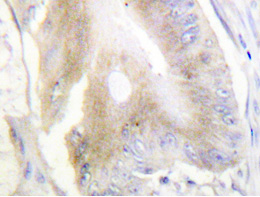Aconitase 1 (ACO1) Rabbit Polyclonal Antibody
Other products for "Aconitase 1"
Specifications
| Product Data | |
| Applications | IF, IHC |
| Recommended Dilution | Immunoflourescence: 1/50-1/200. Immunohistochemistry on Paraffin Sections: 1/50-1/200. |
| Reactivities | Human, Mouse, Rat |
| Host | Rabbit |
| Clonality | Polyclonal |
| Specificity | This antibody detects endogenous levels of IRP-1 protein. |
| Formulation | Phosphate buffered saline (PBS), pH~7.2 containing 0.05% Sodium Azide as preservative. State: Aff - Purified State: Liquid purified Ig fraction (> 95% pure by SDS-PAGE). |
| Concentration | 1.0 mg/ml |
| Purification | Affinity Chromatography using epitope-specific immunogen. |
| Conjugation | Unconjugated |
| Storage | Store the antibody undiluted at 2-8°C for one month or (in aliquots) at -20°C for longer. Avoid repeated freezing and thawing. |
| Stability | Shelf life: One year from despatch. |
| Predicted Protein Size | ~ 98 kDa |
| Gene Name | aconitase 1 |
| Database Link | |
| Background | The insulin receptor substrate-1 (IRS-1), a major substrate of the insulin receptor, is phosphorylated in response to stimulation of cells by insulin, insulin-like growth factor 1 (IGF-1) and interleukin 4 (IL-4). IRS-1 is phosphorylated on serine, threonine and tyrosine residues in a variety of tissues. An insulin-sensitive serine/threonine kinase casein kinase II mediates a portion of the insulin-stimulated serine/threonine phosphorylation of overexpressed IRS-1 in vivo. Thr 502 is identified as the major casein kinase II-catalyzed phosphorylation site in rat IRS-1, and Ser 99 is an additional phosphorylation site catalyzed by casein kinase II. Thus, casein kinase II-catalyzed phosphorylation of IRS-1 may be a component of the intracellular insulin signaling cascade. IRS-1 contains three putative binding sites for 14-3-3 (Ser 270, Ser 374 and Ser 641) and the motif around Ser 270 is located in the phosphortyrosine binding domain of IRS-1, which is responsible for the interaction with the insulin receptor. The association of 14-3-3 with IRS-1 increases significantly upon treatment with okadaic acid, a potent serine/ threonine phosphatase inhibitor. Therefore, the association of 14-3-3 protein may play a role in the regulation of insulin sensitivity by interrupting the association between the insulin receptor and IRS-1. |
| Synonyms | Aconitase, Iron regulatory protein 1, IRP1 |
| Reference Data | |
| Protein Families | Druggable Genome |
| Protein Pathways | Citrate cycle (TCA cycle), Glyoxylate and dicarboxylate metabolism, Metabolic pathways |
Documents
| Product Manuals |
| FAQs |
| SDS |
{0} Product Review(s)
0 Product Review(s)
Submit review
Be the first one to submit a review
Product Citations
*Delivery time may vary from web posted schedule. Occasional delays may occur due to unforeseen
complexities in the preparation of your product. International customers may expect an additional 1-2 weeks
in shipping.






























































































































































































































































 Germany
Germany
 Japan
Japan
 United Kingdom
United Kingdom
 China
China



